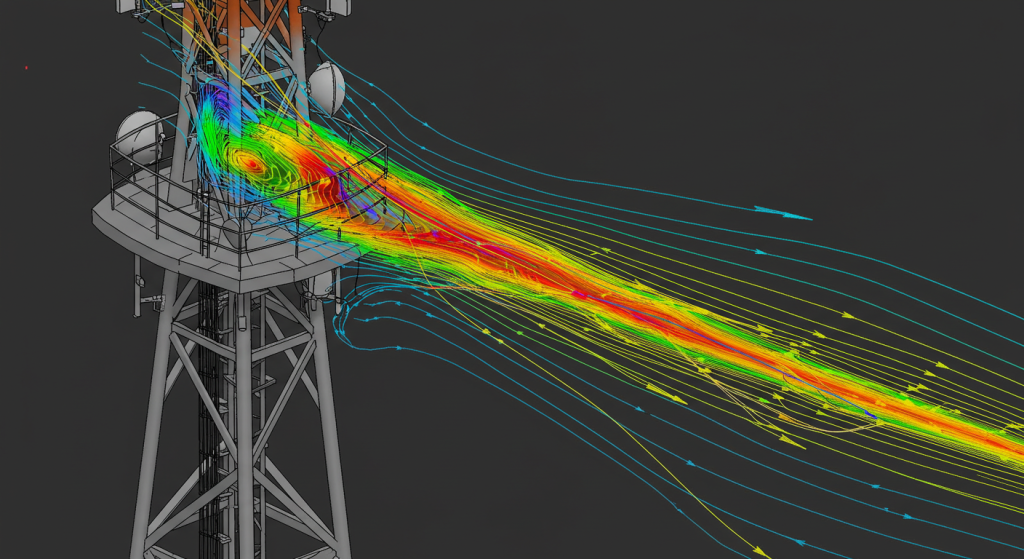Communication Tower Wind Resistance Design for High Wind
2025-07-15
What is Communication Tower Wind Resistance Design?
Communication Tower Wind Resistance Design, simply put, refers to forming a thoroughly tested strategy and method for balancing construction stability, operational effectiveness, and reliability in structural performance to withstand the energetic force of wind. Wind, viewed as a factor of dynamic load, without effective design consideration, would bring about imbalance over the structure, resulting in swaying, oscillations, breakdown, or even more disastrous failure. Wind-resistant towers are designed considering
• The speed of winds in the specific area
• The height and configuration of the tower
• The Weight of Antennas and Other Equipment
• Area of exposure (urban vs rural and mountain vs coastal)
As a company, XY Tower is engaged in the fabrication of wind-resistant communication towers using high tensile galvanized steel, observing internationally accepted standards of safety and contemporary design software.
Ultimate Guide to Communication Tower: Mitigating Failures and Strengthening Structures
In the case of a throttling communication 5G antenna integrated into the steel frame of the city or a transmission tower located on the edge of a coastal cliff, wind resistance is critical for a tower operating in the modern era, in comparison to the older sensitivity eras. In this more detailed report, we cover the most important aspects of communication tower wind resistance design by offering strategic guidelines and techniques necessary for making your tower resilient.
Telcom Towers and Their Reason for Wind Resistance
Telecommunication towers are usually the most prominent structures for miles around. Thus, they are at risk of being struck by winds, storms, and even cyclones. If not properly planned for, wind resistance, in the case of a telecommunication tower, can result in a liability. The following points describe some of the potential outcomes:
- Signal quality is reduced, smothering the signal
- Fatigue due to repeated vibrations can weaken crane joints
- Structural failures can accumulate priceless damage
- There’s a hazard of toppling towers in the network
For telecommunication towers, wind load design constitutes the primary approach to ensuring a safe and reliable, enduring telecommunication infrastructure.
Perfectly Wind-Resistant Towers Engineering
The safety of the users, innovation is the principle of the XY Tower approach to the wind resistance of the tower engineering. Significant Technical Aspects:
• Assessing Wind Load: Implementing STAAD. Ro and SAP2000
• Distribution of Wind Force: Uniform distribution to all structural members
• Calculations on Tower Weights: Dead weight, live weight, and wind load, too.
• Modeling with Finite Elements: Simulate the effect the wind has in reality.
We also observe TIA/EIA-222-G and ASCE’s wind load rules, thus every tower is certified and safe.
Wind Load Design Considerations for Telecommunications Towers
Every area has a defined wind load characteristic. It is the reason why we conduct site-specific assessments to tailor the design as required. Considerations include:
• Elevation of the tower miles: Taller towers receive stronger wind thrust.
• Classification of wind zones regionally: According to wind charts and local regulations.
• Geography: Mountainous vs flat land.
• Configuration of the tower: Monopole lattice or hybrid.
• Loading of equipment: Number, size, position of antennas.
To consider high wind zone operational conditions, structural engineers typically factor in overturning moments, dynamic wind pressure, lateral stability, and many more.

Tower Designs That Excel in Wind Resistance
Different communication towers have varying abilities to withstand powerful wind forces. Within each environment and application, there is a specific tower type that is most suitable. Lattice towers, particularly four-legged ones, are the best for wind resistance because of the wide base and the cross-bracing at the top. Hence, these towers offer great support and stability in rural areas and regions with high wind exposure.
- Monopole towers are most commonly used in urban areas and on rooftops, as they take up less space and are visually pleasing. However, these towers provide only moderate wind resistance when compared to other types. Guyed towers have a reasonable amount of wind resistance and provide it at a lower material price. However, the need for vast open areas makes them less suitable for dense or constrained locations.
- Self-supporting towers do not require guy wires, which allows them to excel in wind resistance. These towers combine strength and compactness, which makes them perfect for urban areas and coastal regions where a small footprint is desired without compromising on reliability.
Standards and Compliance: What the Law Requires
There are limits to what we can do when it comes to designing towers for wind. We conform to:
• The TIA/EIA-222-H standards for antenna-supporting structures
• IEC 61936-1 concerning wind zones and pressure levels
• The ISO 9001-certified design process
• Local building codes, including seismic considerations
These make certain that every tower, regardless of whether it is located in a desert, cyclone-prone area, or a dense urban zone, is built to international safety standards.
Site-Specific Customizations for Wind Resistance
A uniform approach does not exist in tower design. Each of our towers is equipped with:
• Modular steel sections for convenient transport
• Cross-bracing systems for vibration control
• Precision welded joints to withstand dynamic loads
• Foundation anchoring systems tailored to soil and wind assessments
We customize wind resistance from rural versus urban requirements to coastal and tailless regions to ensure performance and durability.
Challenges in Wind Resistance Design
Despite all the tech innovations, wind resistance still poses design challenges. We face:
• Inconsistent wind data across regions
• Post-installation changes in antenna weight
• Wind tunnel effects in urban settings
• Coastal zone corrosion threats
Our towers include hot-dip galvanization and application of corrosion-resistant coatings, which is why these features are standard in our towers.
Best Tip for Wind Resistance in Communication Towers
For improving wind resistance on communication towers, a site-specific wind load assessment should be done before the iron works fabrication, which happens after the tower is erected. Every region has its wind signature. What may work in a valley would not stand on a windy coastline or a mountaintop.
- Engineers study wind speed data, terrain altitudes, obstructions, and prevailing winds to assess the actual force that will be applied to the tower. Structural modifications such as additional bracing, base widening, or reinforced steel members become possible because of these predictions.
- The wind engineering simulations are provided by advanced software tools like STAAD.Pro and SAP2000 ensure that extreme winds will not cause the tower to sway excessively or suffer from structural fatigue.
- Choose TIA/EIA-222 compliant towers and galvanized steel constructions for enhanced storm resistance and corrosion durability. These cross-braced exoskeletons that dampen wind-induced vibrations while rigidly anchoring to the ground are also effective for wind retardation.
Acquiring a Wind-Resistant Tower
With us at XY Tower, it’s simple. Just go to our Contact Page, and we will:
1. Conduct a site assessment (terrain, wind zone, and soil types)
2. Model the appropriate tower type and height
3. Design using internationally recognized wind standards
4. Produce and deliver modular components
5. Provide remote or in-person installation support
Conclusion:
Wind may be invisible, but its impact is powerful. With our engineering resilience and reliability in communication tower wind resistance design, peace of mind is always guaranteed when the right wind-resistant design is applied. Whether expanding a national 5G network or deploying a mission-critical tower in mountain terrain, we construct these towers so that they will withstand harsh conditions. You can always count on XY Tower for custom-engineered towers that adhere to global wind resistance standards and ensure an uninterrupted network during the fiercest storms.

Hey, I’m Chunjian Shu
"X.Y. Tower: Reliable, innovative solutions for high-quality towers and electrical equipment with professional service.
